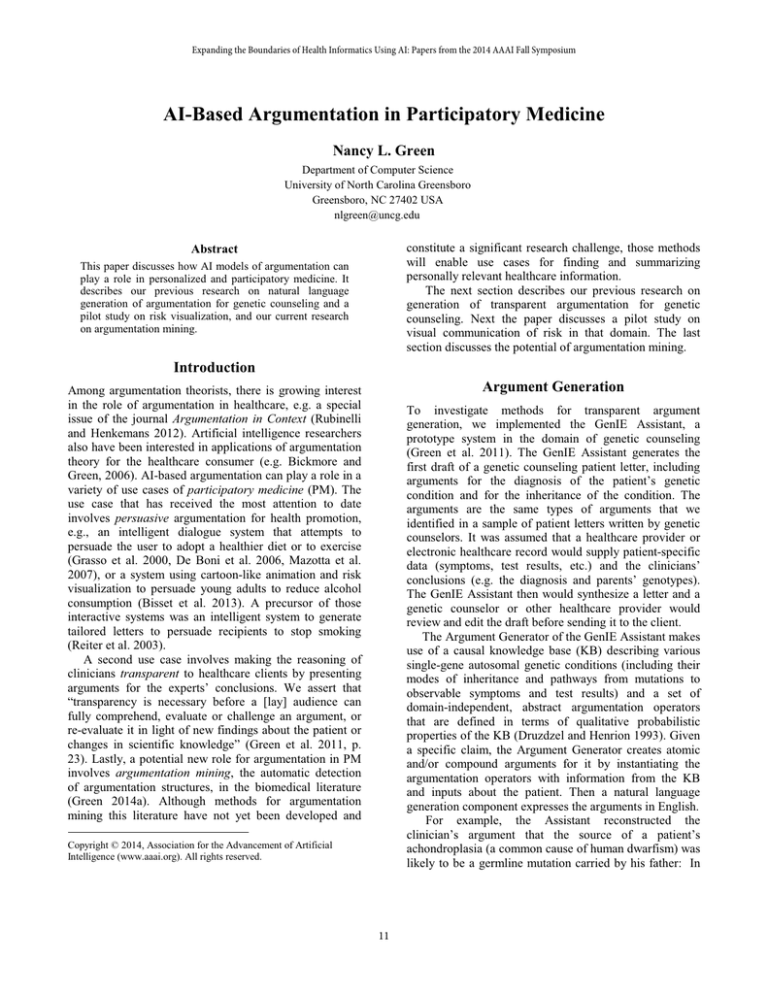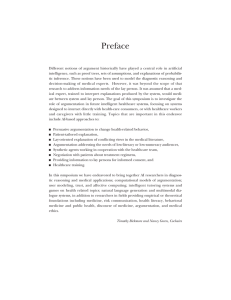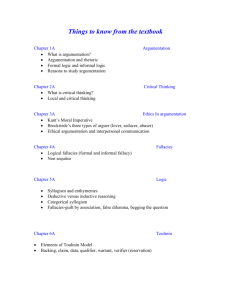
Expanding the Boundaries of Health Informatics Using AI: Papers from the 2014 AAAI Fall Symposium
AI-Based Argumentation in Participatory Medicine
Nancy L. Green
Department of Computer Science
University of North Carolina Greensboro
Greensboro, NC 27402 USA
nlgreen@uncg.edu
constitute a significant research challenge, those methods
will enable use cases for finding and summarizing
personally relevant healthcare information.
The next section describes our previous research on
generation of transparent argumentation for genetic
counseling. Next the paper discusses a pilot study on
visual communication of risk in that domain. The last
section discusses the potential of argumentation mining.
Abstract
This paper discusses how AI models of argumentation can
play a role in personalized and participatory medicine. It
describes our previous research on natural language
generation of argumentation for genetic counseling and a
pilot study on risk visualization, and our current research
on argumentation mining.
Introduction
Argument Generation
Among argumentation theorists, there is growing interest
in the role of argumentation in healthcare, e.g. a special
issue of the journal Argumentation in Context (Rubinelli
and Henkemans 2012). Artificial intelligence researchers
also have been interested in applications of argumentation
theory for the healthcare consumer (e.g. Bickmore and
Green, 2006). AI-based argumentation can play a role in a
variety of use cases of participatory medicine (PM). The
use case that has received the most attention to date
involves persuasive argumentation for health promotion,
e.g., an intelligent dialogue system that attempts to
persuade the user to adopt a healthier diet or to exercise
(Grasso et al. 2000, De Boni et al. 2006, Mazotta et al.
2007), or a system using cartoon-like animation and risk
visualization to persuade young adults to reduce alcohol
consumption (Bisset et al. 2013). A precursor of those
interactive systems was an intelligent system to generate
tailored letters to persuade recipients to stop smoking
(Reiter et al. 2003).
A second use case involves making the reasoning of
clinicians transparent to healthcare clients by presenting
arguments for the experts’ conclusions. We assert that
“transparency is necessary before a [lay] audience can
fully comprehend, evaluate or challenge an argument, or
re-evaluate it in light of new findings about the patient or
changes in scientific knowledge” (Green et al. 2011, p.
23). Lastly, a potential new role for argumentation in PM
involves argumentation mining, the automatic detection
of argumentation structures, in the biomedical literature
(Green 2014a). Although methods for argumentation
mining this literature have not yet been developed and
To investigate methods for transparent argument
generation, we implemented the GenIE Assistant, a
prototype system in the domain of genetic counseling
(Green et al. 2011). The GenIE Assistant generates the
first draft of a genetic counseling patient letter, including
arguments for the diagnosis of the patient’s genetic
condition and for the inheritance of the condition. The
arguments are the same types of arguments that we
identified in a sample of patient letters written by genetic
counselors. It was assumed that a healthcare provider or
electronic healthcare record would supply patient-specific
data (symptoms, test results, etc.) and the clinicians’
conclusions (e.g. the diagnosis and parents’ genotypes).
The GenIE Assistant then would synthesize a letter and a
genetic counselor or other healthcare provider would
review and edit the draft before sending it to the client.
The Argument Generator of the GenIE Assistant makes
use of a causal knowledge base (KB) describing various
single-gene autosomal genetic conditions (including their
modes of inheritance and pathways from mutations to
observable symptoms and test results) and a set of
domain-independent, abstract argumentation operators
that are defined in terms of qualitative probabilistic
properties of the KB (Druzdzel and Henrion 1993). Given
a specific claim, the Argument Generator creates atomic
and/or compound arguments for it by instantiating the
argumentation operators with information from the KB
and inputs about the patient. Then a natural language
generation component expresses the arguments in English.
For example, the Assistant reconstructed the
clinician’s argument that the source of a patient’s
achondroplasia (a common cause of human dwarfism) was
likely to be a germline mutation carried by his father: In
Copyright © 2014, Association for the Advancement of Artificial
Intelligence (www.aaai.org). All rights reserved.
11
summary, the patient was diagnosed as having
achondroplasia due to a single G1138A mutation of the
FGFR3 gene, which must have been inherited from his
mother or father. Neither parent has symptoms of
achondroplasia, so neither is likely to have the mutation in
every cell. However, the father is 45 years old and being
over 35 years old increases the risk of having a new
change in a reproductive cell, called a germline mutation.
Therefore, the father could have a germline G1138A
mutation that was inherited by the patient and is the cause
of his condition.
In current practice, patient letters are written by
genetic counselors for documentation purposes, e.g. for
future care providers, and for informational, educational,
and counseling purposes for clients. However, as the role
of genetics in medicine increases, the potential benefit of
at least partially automating this writing process is
obvious. Moreover, as the PM paradigm shifts more
responsibility to healthcare consumers, it is vital that they
have access to the argumentation supporting the diagnosis,
prognosis, and/or treatment options presented to them.
Ideally, patients should be able to engage, at any time,
with a system with the capacity to present and explain all
points of view about their case. Ideally, the system could
respond to questions and challenges from the user. Also,
as new biomedical knowledge becomes available that
strengthens the original arguments or that conflicts with
their original assumptions, such a system could notify the
patient of these changes.
cumulative risk for HNPCC versus non-HNPCC
individuals (Figure 1) would be less preferred and less
effective than a display of natural frequencies (Gigerenzer
2002) (Figure 2) or a dot matrix (Figure 3).
Figure 1. Line graph display.
Risk Visualization
Understanding genetic risk is often necessary for making
an informed decision, whether to modify one’s behavior to
reduce risk (e.g. to lose weight to reduce risk of colon
cancer) or to select among treatment options (e.g. after a
diagnosis that one carries a BRCA1 mutation). New
methods of personal genomic testing can provide presymptomatic, probabilistic risk assessment for many
common multifactorial disorders. However, the challenges
of effective health risk communication are well known
(Ancker and Kaufman 2007). Health communication
researchers have studied various visualization techniques
to improve risk communication (Ancker et al. 2006,
Lipkus 2007). Ideally, an AI-based system would be able
to use that type of knowledge to tailor risk graphics to a
model of the user and to provide a real-time explanation
of any part of the visualization that the viewer does not
understand (Green 2011).
As a step towards integrating AI-based argumentation
and risk visualization, we performed a pilot study to
evaluate the comparative effectiveness of three graphics
for depicting the risk of colon cancer of someone who has
the mutation for hereditary nonpolyposis colon cancer
(HNPCC). Based upon a survey of the literature, our
hypothesis was that the first graphic, a line graph showing
Figure 2. Natural frequencies display.
Figure 3. Dot matrix display.
12
The three graphics were implemented in Java, each on
a separate screen. A slider at the bottom of each screen
enabled the user to select the age of the patient for which
the risk information was shown and to see how the risk
changes over time. Eleven university student volunteers
from an introductory course on use of computer
application software were invited to look at the applets
and complete a short survey. Contrary to our expectations,
the majority of participants said that they found all three
types of graphics clear and understandable, and equal
numbers said that they liked the line graph (5/11) and the
natural frequency graphic (5/11) best. A majority (8/11)
liked the dot matrix the least. However, for both the line
graph and the natural frequencies graphic, only 6/11
correctly answered the fundamental question, Are more
people with HNPCC diagnosed with colon cancer by age
70 than people who do not have HNPCC? Only 4/11
correctly answered that question using the dot matrix. This
raises the question of how to support argument
transparency when the recipient may not even
comprehend the supporting data, while believing that he
does. (However, as the referees of this paper have pointed
out, the intended meaning of this question may have been
unclear. The intended meaning was: By age 70, is a
person with the HNPCC mutation more likely to be
diagnosed with colon cancer than a person without the
HNPCC mutation?)
arNSHL, all but the c.637+1G>T variant of CABP2 could
be eliminated as candidates, (A3) the c.637+1G>T variant
segregates with arNSHL in that individual’s family but not
in a control group, (A4) the c.637+1G>T variant
segregates with arNSHL in two other families, perhaps
distantly related to each other and the first family, (A5)
there is a partial biochemical explanation for how the
variant could lead to hearing loss, but (A6) the variant was
not found in some other individuals with hearing loss.
Note that A1 provides partial support for A2, A2 provides
partial support for A3, and A3-A5 provide support for the
argument that the variant is one of the causes of arNSHL,
while A6 is not an argument against that claim.
Since many acceptable arguments used in science (as
well as in law and everyday reasoning) are not necessarily
deductively valid, it is important to test the critical
questions of such arguments (Walton et al. 2008). For
example, a critical question to ask of A4 is: Is there some
other factor present in the affected individuals and absent
in the unaffected individuals that could account for the
condition? Another critical question of A4 that is partially
addressed in A5 is: Is there a plausible causal mechanism
explaining how the c.637+1G>T variant could cause the
condition? When applying biomedical studies to
particular patients, an important critical question is
whether the population that was studied is representative
of this patient, i.e., whether or not the study is applicable
to her.
To illustrate a few of the techniques that have been
investigated so far for argumentation mining, Mochales
and Moens (2011) applied statistical techniques to legal
documents to classify whether a sentence is part of an
argument, to determine the boundaries of arguments, and
to classify the premises and conclusion of arguments.
Cabrio and Villata (2012) used textual entailment to
detect support and attack relations between arguments in a
corpus of on-line debates. A number of other researchers
have investigated automatic classification of sentences in
scientific documents to identify novel knowledge claims
and components of a scientific investigation (e.g. Teufel
2010, Liakata et al. 2012). While previous researchers
have attempted to extract useful information without the
need to represent or reason about the domain, we plan to
supplement those techniques with use of domain
knowledge about genetics.
In the future, argumentation mining technology could
provide healthcare consumers with an argumentation
structure for the biomedical knowledge on which the
clinician’s conclusions about their case (diagnosis,
prognosis, treatment options, etc.) is based. Exposing the
structure of the argumentation enables the patient to
evaluate the acceptability of any of the premises in a chain
of arguments and to test the critical questions of the
arguments.
Argumentation Mining
Argumentation mining is the process of detecting
argumentation structure in one or more documents.
Argumentation structure consists of each atomic argument
(premises and conclusion), the type of each argument, and
the relationships among the atomic arguments, e.g., when
one argument attacks another argument, where multiple
independent arguments support the same conclusion, or
where one argument supports a premise of another
argument. A relatively new area of natural language
processing research, it has explored techniques for mining
existing corpora of non-science content, e.g. legal
documents and product reviews. Our goal is to create a
freely available corpus of open-access, full-text scientific
articles from the biomedical genetics research literature,
annotated with argumentation structures to support this
type of research (Green 2014a).
As a step towards developing an annotated corpus, we
have analyzed the argumentation in a representative article
(Schrauwen et al. 2012) whose main claim is that a
c.637+1G>T mutation of the CABP2 gene is a cause of
autosomal recessive non-syndromic hearing loss
(arNSHL) (Green 2014b). The argumentation structure of
this article can be summarized as: (A1) Justification for
looking at a particular region of chromosome 11 for a
candidate cause of arNSHL, (A2) after identifying the
variants in that region of an individual affected with
13
Green, N.L. 2014b. Argumentation for Scientific Claims in a
Biomedical Research Article. To appear in CEUR Proceedings
of Frontiers and Connections between Argumentation Theory
and Natural Language Processing, Bertinoro, Italy, July 21-25,
2014.
Acknowledgments
Graduate student Caleb Brough implemented the risk
visualization program, facilitated the user study, and
tabulated the data. Dr. Malcolm Schug of the UNCG
Department of Biology verified our interpretation of
arguments in the genetics research literature.
Green, N., Dwight, R., Navoraphan, K., and Stadler, B. 2011.
Natural language generation of biomedical argumentation for lay
audiences. Argument and Computation 2(1), 23-50.
References
Liakata, M. et al. 2012. Automatic recognition of
conceptualization zones in scientific articles and two life science
applications. Bioinformatics 28(7).
Ancker, J.S. and Kaufman, D. 2007. Rethinking Health
Numeracy: A Multidisciplinary Literature Review. Journal of
the American Medical Informatics Association 14(6):713-721.
Lipkus, I.M. 2007. Numeric, Verbal, and Visual Formats of
Conveying Health Risks: Suggested Best Practices and Future
Recommendations. Medical Decision Making 27: 696-713.
Ancker, J.S., Senathirajah, Y., Kukafka, R., and Starren, J.
2006. Design Features of Graphs in Health Risk
Communication: A Systematic Review. Journal of the American
Medical Informatics Association 13:608-618.
Mazotta, I., de Rosis, F., and Carofiglio, V.P. 2007. A useradapted persuasion system in the healthy-eating domain. IEEE
Intelligent Systems 22: 42-51.
Bickmore, T. and Green, N. 2006. (Eds.) Proceedings of AAAI
2006 Spring Symposium: Argumentation for Consumers of
Healthcare.
Mochales, R. and Moens, M. 2011. Argumentation mining.
Artificial Intelligence and Law 19, 1-22.
Bisset, S., Wood, S., Cox, R., Scott, D., and Cassell, J. 2013.
Calculating alcohol risk in a visualization tool for promoting
healthy behavior. Patient Education and Counseling 92(2), pp.
167-173.
Reiter, E., Robertson, R., and Osman, L. 2003. Lessons from
failure: generating tailored smoking cessation letters. Artificial
Intelligence 144: 41-58.
Rubinelli, S. and Henkemans, A. F. 2012. Argumentation in the
healthcare domain. Journal of Argumentation in Context 1(1),
1-3.
Cabrio, E. and Villata, S. 2012. Generating Abstract Arguments:
A Natural Language Approach. In Verheij, B., Szeider, S., and
Woltran, S. (eds.) Computational Models of Argument:
Proceedings of COMMA 2012. Amsterdam, IOS Press, 454-461.
Schrauwen et al. 2012. A mutation in CABP2, expressed in
cochlear hair cells, causes autosomal recessive hearing
impairment. The American Journal of Human Genetics 91, 63645.
De Boni, M., Hurling, R., Dryden, W. 2006. Argumentation
through an automated rational-emotive behavior therapy system
for change in exercise behavior. In Proceedings of AAAI 2006
Spring Symposium: Argumentation for Consumers of
Healthcare, 34-8.
Teufel, S. 2010. The Structure of Scientific Articles:
Applications to Citation Indexing and Summarization. Stanford,
CA, CSLI Publications.
Druzdzel, M.J. and Henrion, M. 1993. Efficient reasoning in
qualitative probabilistic networks. In Proc. of the 11th Nat. Conf.
on AI (AAAI-93), pp. 548-53.
Walton, D., Reed, C., and Macagno, F. 2008. Argumentation
Schemes. Cambridge University Press.
Gigerenzer, G. 2002. Reckoning with Risk: Learning to Live
with Uncertainty. London: Penguin Books.
Grasso, F., Cawsey, A., Jones, R.
2000. Dialectical
argumentation to solve conflicts in advice giving: a case study in
the promotion of healthy nutrition. International Journal of
Human-Computer Studies 53, 1077-115.
Green, N.L 2011. Artificial Intelligence and Risk
Communication. In Proceedings of AAAI 2011 Spring
Symposium
on
Artificial
Intelligence
and
Health
Communication.
Green, N.L. 2014a. Towards creation of a corpus for
argumentation mining the biomedical genetics research
literature. In Proceedings of the First Workshop on
Argumentation Mining, Baltimore, MD, June 26, 2014.
14





